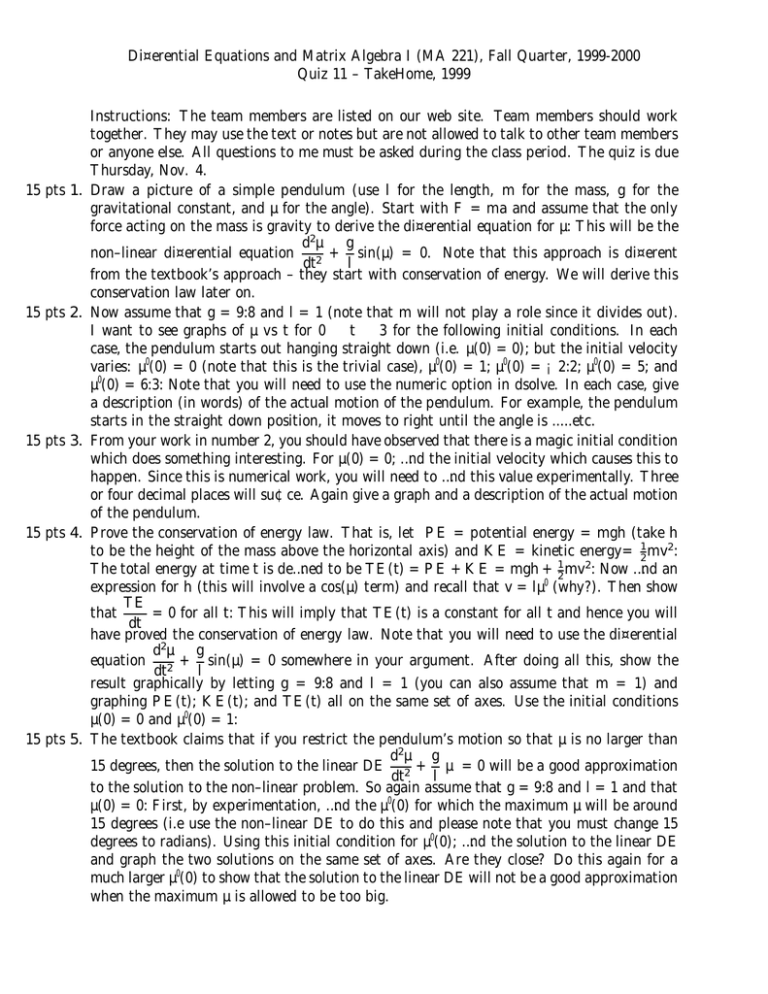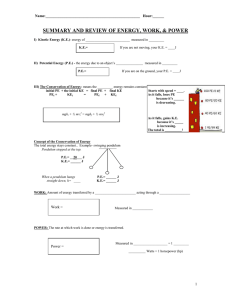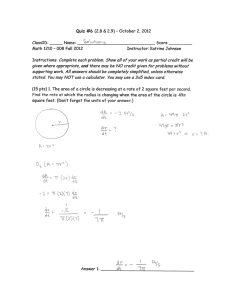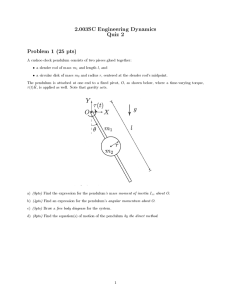Di¤erential Equations and Matrix Algebra I (MA 221), Fall Quarter,... Quiz 11 – TakeHome, 1999
advertisement

Di¤erential Equations and Matrix Algebra I (MA 221), Fall Quarter, 1999-2000 Quiz 11 – TakeHome, 1999 15 pts 1. 15 pts 2. 15 pts 3. 15 pts 4. 15 pts 5. Instructions: The team members are listed on our web site. Team members should work together. They may use the text or notes but are not allowed to talk to other team members or anyone else. All questions to me must be asked during the class period. The quiz is due Thursday, Nov. 4. Draw a picture of a simple pendulum (use l for the length, m for the mass, g for the gravitational constant, and µ for the angle). Start with F = ma and assume that the only force acting on the mass is gravity to derive the di¤erential equation for µ: This will be the d2 µ g non–linear di¤erential equation 2 + sin(µ) = 0. Note that this approach is di¤erent dt l from the textbook’s approach – they start with conservation of energy. We will derive this conservation law later on. Now assume that g = 9:8 and l = 1 (note that m will not play a role since it divides out). I want to see graphs of µ vs t for 0 t 3 for the following initial conditions. In each case, the pendulum starts out hanging straight down (i.e. µ(0) = 0); but the initial velocity varies: µ0 (0) = 0 (note that this is the trivial case), µ0 (0) = 1; µ 0 (0) = ¡2:2; µ 0 (0) = 5; and µ0 (0) = 6:3: Note that you will need to use the numeric option in dsolve. In each case, give a description (in words) of the actual motion of the pendulum. For example, the pendulum starts in the straight down position, it moves to right until the angle is .....etc. From your work in number 2, you should have observed that there is a magic initial condition which does something interesting. For µ(0) = 0; …nd the initial velocity which causes this to happen. Since this is numerical work, you will need to …nd this value experimentally. Three or four decimal places will su¢ce. Again give a graph and a description of the actual motion of the pendulum. Prove the conservation of energy law. That is, let P E = potential energy = mgh (take h to be the height of the mass above the horizontal axis) and KE = kinetic energy= 21 mv2 : The total energy at time t is de…ned to be T E(t) = P E + KE = mgh + 21 mv 2 : Now …nd an expression for h (this will involve a cos(µ) term) and recall that v = lµ0 (why?). Then show TE that = 0 for all t: This will imply that T E(t) is a constant for all t and hence you will dt have proved the conservation of energy law. Note that you will need to use the di¤erential d2 µ g equation 2 + sin(µ) = 0 somewhere in your argument. After doing all this, show the dt l result graphically by letting g = 9:8 and l = 1 (you can also assume that m = 1) and graphing P E(t); KE(t); and T E(t) all on the same set of axes. Use the initial conditions µ(0) = 0 and µ0 (0) = 1: The textbook claims that if you restrict the pendulum’s motion so that µ is no larger than d2 µ g 15 degrees, then the solution to the linear DE 2 + µ = 0 will be a good approximation dt l to the solution to the non–linear problem. So again assume that g = 9:8 and l = 1 and that µ(0) = 0: First, by experimentation, …nd the µ 0 (0) for which the maximum µ will be around 15 degrees (i.e use the non–linear DE to do this and please note that you must change 15 degrees to radians). Using this initial condition for µ0 (0); …nd the solution to the linear DE and graph the two solutions on the same set of axes. Are they close? Do this again for a much larger µ0 (0) to show that the solution to the linear DE will not be a good approximation when the maximum µ is allowed to be too big.





